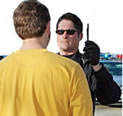|

DRE = Drug Recognition Expert
DIE = Drug Influence Evaluation
(aka Drug Recognition Exam)
LEDA = Law Enforcement Drug
AssessmentAre NHTSA's validation
studies valid?
My recent peer-reviewed scientific journal article,
Kane 2013,
can help attorneys on both sides understand
DIE science and DRE testimony. This is
the first peer-reviewed scientific research
focused on what scientists call the "methodological
quality" of NHTSA's DRE/DIE validation
studies. Are NHTSA's DRE/DIE validation
studies themselves valid?
|
Kane, G. The Methodological
Quality of Three Foundational Law Enforcement
Drug Influence Evaluation Validation Studies.
J Negat Results Biomed. 2013 Nov 4;12(1):16.
doi:10.1186/1477-5751-12-16.
Abstract
BACKGROUND: ....This paper first
identifies the
scientific studies commonly cited in American
criminal trials as evidence of DIE accuracy,
and second, uses the QUADAS tool to investigate
whether the methodologies used by these
studies allow them to correctly quantify
the diagnostic accuracy of the DIEs currently
administered by US law enforcement.
Conclusion
Bigelow, Compton and Adler, the three
validation studies commonly cited in
Bigelow = Johns Hopkins
Compton = LAPD 173
Adler = AZ DRE Validation
American criminal prosecutions to quantify
the accuracy of current US law enforcement
DIE practice, did no reference testing
of driving performance or physical or
mental impairment, investigated tests
different from those currently employed
by US law enforcement, used methodologies
that biased accuracies, and reported DIE
accuracy statistics that are not externally
valid. The LEDA [DRE/DIE] accuracies reported
by these studies do not quantify the accuracy
of the DIE process now used by US law
enforcement. These validation studies
do not validate current DIE practice.
|
| |
Kane 2013
is peer-reviewed science concluding that
current DIEs are not validated by their
official validation studies
|
|
|
 Current
US law enforcement DIE testing has no
identifiable scientific accuracy. Follow
me on this. At your next DUID trial, if
asked, the DRE officer will testify that
the scientific DIE test he administered
to D is scientifically accurate because
scientific validation studies —Johns
Hopkins, LAPD 173— did a bunch
of DIEs, and discovered that, sure enough,
DIEs are accurate. 98% accurate.
87% accurate. Something like that.
Your D's DRE knows his testing of D was
accurate, because he did the same testing
the LAPD 173 officers did. They were accurate.
He was accurate. It just makes sense. Current
US law enforcement DIE testing has no
identifiable scientific accuracy. Follow
me on this. At your next DUID trial, if
asked, the DRE officer will testify that
the scientific DIE test he administered
to D is scientifically accurate because
scientific validation studies —Johns
Hopkins, LAPD 173— did a bunch
of DIEs, and discovered that, sure enough,
DIEs are accurate. 98% accurate.
87% accurate. Something like that.
Your D's DRE knows his testing of D was
accurate, because he did the same testing
the LAPD 173 officers did. They were accurate.
He was accurate. It just makes sense.
Kane 2013,
a peer-reviewed scientific journal article,
demonstrates that the officer is wrong
(§ Accuracy). The prosecution
has no peer-reviewed science to contradict
Kane 2013's conclusions. Thus, the
DRE has no scientific basis for testifying
to any accuracy for the DIE he administered to D.
|
| |
Kane 2013
is peer-reviewed science that IDENTIFIES
BIASING METHODOLGIES that invalidate any
DIE validation project that uses them,
including the DRE officer's training and
personal experience.
|
|
1
|
 The
DIE accuracies
reported in NHTSA's validation studies
(and testified to by DRE officers) are
internally valid, but not externally
valid. They
do not describe the accuracy of the DIE
administered to the defendant in any DUID
prosecution. I said earlier
that science is harder than you'd think.
This is one of those times. NHTSA's practice
of using the "accuracy" of a
test, as measured in a validation study,
to describe the predictive power of the
same test in a criminal prosecution is
scientifically wrong. Although this seems
at first to offend our common sense notion
of cause and effect, it has been understood
by science since 1762. Kane 2013 explains
(with references). The
DIE accuracies
reported in NHTSA's validation studies
(and testified to by DRE officers) are
internally valid, but not externally
valid. They
do not describe the accuracy of the DIE
administered to the defendant in any DUID
prosecution. I said earlier
that science is harder than you'd think.
This is one of those times. NHTSA's practice
of using the "accuracy" of a
test, as measured in a validation study,
to describe the predictive power of the
same test in a criminal prosecution is
scientifically wrong. Although this seems
at first to offend our common sense notion
of cause and effect, it has been understood
by science since 1762. Kane 2013 explains
(with references).
"Some
diagnostic test accuracy statistics
are externally valid (generalizable
to populations other than the one in
the study), some are not. PPV —“arrest
accuracy”, or “accuracy
of the arresting officers’ toxicology
predictions”— is not externally
valid. It depends on prevalence [27-30].
Because the prevalence of drug impairment
changes as time and location change,
even when officers make exactly the
same measurements and interpret them
with exactly the same criteria, the
accuracy of the officers’ predictions
changes depending on where and when
the test is administered." Kane 2013, § Accuracy
of diagnostic tests, pg 2
Any attempt
by the prosecution to use the accuracy
of the DIE is, scientifically, wrong.
|
|
2
|
DRE officers'
amazing predictions not so amazing after
all
NHTSA's validation studies never
say DIEs are accurate at predicting driving
performance.
NHTSA's validation studies never
say DIEs are accurate at predicting driving
impairment.
NHTSA's validation studies never
say DIEs are accurate at predicting drug
impairment.
NHTSA's validation studies never
say DIEs are accurate at predicting impairment
of any kind.
 When
NHTSA's validation studies report something
is accurate, the thing they say is accurate
is DRE officers' predictions of the presence
of drugs in a person's blood —after the officer
has asked "Are you taking any drugs?"
(Step 2 of the 12-step
protocol). What NHTSA's science proves
is, if you tell a trained, certified traffic-police
Drug Recognition Expert that you
have taken a drug, the officer will be
highly accurate at predicting that you
have taken a drug. When
NHTSA's validation studies report something
is accurate, the thing they say is accurate
is DRE officers' predictions of the presence
of drugs in a person's blood —after the officer
has asked "Are you taking any drugs?"
(Step 2 of the 12-step
protocol). What NHTSA's science proves
is, if you tell a trained, certified traffic-police
Drug Recognition Expert that you
have taken a drug, the officer will be
highly accurate at predicting that you
have taken a drug.
"[T]he
circular question DIE validation studies
rely on to confirm driver impairment,
'How else could officers have made specific
drug predictions?' has a straightforward
answer, 'By selecting for inclusion
in the study people who confessed or
had drugs found in a search.'"
Kane 2013, § QUADAS Item 3,
misclassification bias
|
|
3
|
Statements
about the scientific accuracy of a Defendant's
DRE/DIE test are valid and reliable only
if they are based on scientific data for
D's particular drug. None
of the studies the DRE officer has knowledge
of give relevant data for D's drug.
"'Drug'
is not a homogenous medical entity and
the accuracy of DRE Opinions varies
from drug to drug. Using Compton's sample
group as an example, sensitivity for
PCP (phencyclidine) was 91%, but for
cocaine 19%. Counting a correct PCP
prediction as indicating the accuracy
of cocaine predictions misclassifies
that PCP result and misstates the accuracy
of the LEDA [DRE/DIE] when an officer
predicts cocaine."
Kane 2013, § QUADAS Item 3
|
|
4
|
Key
elements of the traffic-police DIE are
not standardized
"None
of the three studies described what
their LEDA SA [DIE] findings were, or
how those findings were combined to
formulate DRE Opinions. The validation
studies' LEDA DRE Opinions cannot be
reproduced.
Current US law enforcement DIE methods
do not reproduce the LEDA methods investigated
in Bigelow, Compton and Adler. The accuracies
reported in these studies do not reflect
the accuracy of current DIEs."
Kane 2013 § QUADAS Item 8,
index test reproducibility
|
|
5
|
The Arizona
DRE study reports a high DIE accuracy,
calculated by hiding DIE wrong answers.
Kane 2013, § QUADAS Item 10 and 11—review
bias, pg 8
LAPD 173
reports a 94% DIE accuracy, calculated
by counting DRE officers' wrong answers
as correct. Kane 2013 § QUADAS
Item 10 and 11—review bias, pg 8.
In fact LAPD
173 failed to prove DREs were any more
accurate than random guessing.
"Compton's
methodology failed to demonstrate that
the LEDA-like [DRE/DIE] tests the study
investigated were any more accurate
than random guessing." Kane 2013, § Accuracies,
pg 8, see also Endnote a, pg 10
|
|
6
|
The list of "7 drug categories"
in the DRE Student Manual differs from
the lists validated by Bigelow, Compton
and Adler, whose lists differ from each
other. [Table 2, pg 7]
|
|
7
|
Etc. Download a full-text
pdf of Kane 2013 from the JNRBM
web site, free.
|
|
![]()



 Current
US law enforcement DIE testing has no
identifiable scientific accuracy. Follow
me on this. At your next DUID trial, if
asked, the DRE officer will testify that
the scientific DIE test he administered
to D is scientifically accurate because
scientific validation studies —Johns
Hopkins, LAPD 173— did a bunch
of DIEs, and discovered that, sure enough,
DIEs are accurate. 98% accurate.
87% accurate. Something like that.
Your D's DRE knows his testing of D was
accurate, because he did the same testing
the LAPD 173 officers did. They were accurate.
He was accurate. It just makes sense.
Current
US law enforcement DIE testing has no
identifiable scientific accuracy. Follow
me on this. At your next DUID trial, if
asked, the DRE officer will testify that
the scientific DIE test he administered
to D is scientifically accurate because
scientific validation studies —Johns
Hopkins, LAPD 173— did a bunch
of DIEs, and discovered that, sure enough,
DIEs are accurate. 98% accurate.
87% accurate. Something like that.
Your D's DRE knows his testing of D was
accurate, because he did the same testing
the LAPD 173 officers did. They were accurate.
He was accurate. It just makes sense.
 The
The